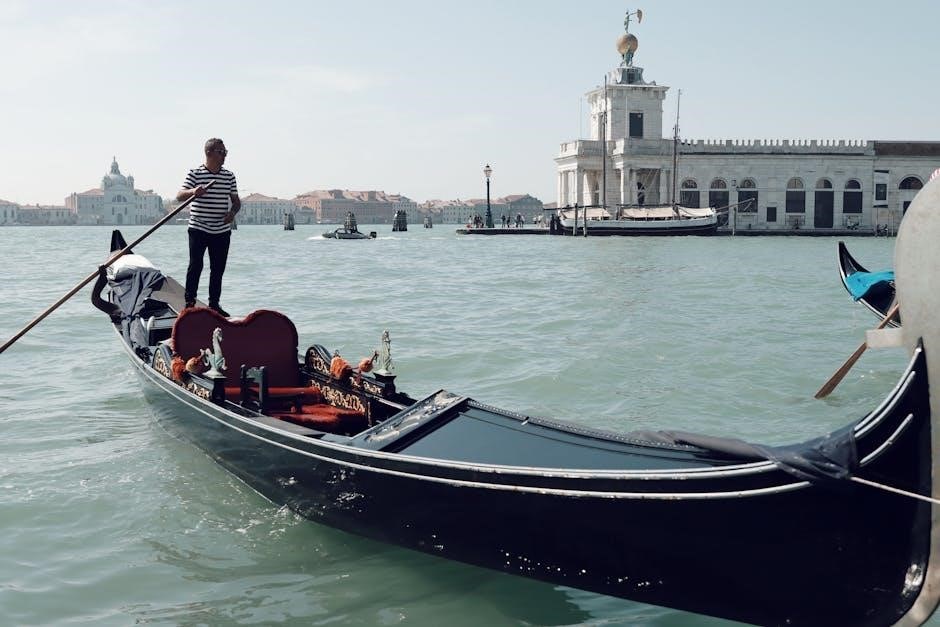Samuel Taylor Coleridge’s The Rime of the Ancient Mariner is a seminal work in English Romanticism, exploring guilt, nature, and the supernatural through its haunting narrative and vivid imagery․
Background of the Poem
The Rime of the Ancient Mariner was first conceived during a collaboration between Samuel Taylor Coleridge and William Wordsworth, aimed at creating a narrative poem to help fund a journey․ The idea originated from a dream by Coleridge’s friend, James Cruikshank, which inspired the haunting tale of guilt and redemption․ The poem was initially part of the Lyrical Ballads, a joint publication with Wordsworth in 1798, designed to challenge traditional poetry forms․ Its unique blend of supernatural elements and moral reflection set it apart, drawing both praise and criticism․ The mariner’s journey, driven by his fatal act of killing the albatross, became a cornerstone of Romantic literature, exploring themes of isolation, nature, and the human condition․
Publication History
The Rime of the Ancient Mariner was first published in 1798 as part of the inaugural edition of Lyrical Ballads, a collaborative effort with William Wordsworth․ The poem initially appeared anonymously, alongside other works, and was met with mixed reviews due to its unconventional style․ Over the years, Coleridge revised the poem multiple times, with the final version published in 1834, featuring a marginal gloss that provided context and deeper meaning․ The poem’s enduring popularity has led to numerous editions and adaptations, making it accessible in various formats, including PDF, for modern readers and scholars․ Its publication history reflects its evolution from a controversial piece to a celebrated masterpiece of Romantic literature․
Significance in Romantic Literature
The Rime of the Ancient Mariner holds a pivotal place in Romantic literature, embodying key themes of the movement such as the power of nature, individual guilt, and the supernatural․ Its exploration of human isolation and the psychological effects of sin resonated deeply with readers, setting a new standard for narrative poetry․ The poem’s use of vivid imagery and symbolic elements influenced later Romantic writers, shaping the genre’s focus on emotion and the sublime․ Its enduring relevance continues to inspire modern interpretations, solidifying its status as a cornerstone of Romanticism and a timeless exploration of the human condition․ The work remains essential for understanding the literary shifts of the late 18th and early 19th centuries․
Historical Context
Published in 1798, The Rime of the Ancient Mariner emerged during the Romantic era, reflecting Coleridge’s fascination with nature, guilt, and the supernatural, influencing later literary movements․
Romanticism and Its Influence
The Rime of the Ancient Mariner stands as a quintessential Romantic poem, embodying the movement’s emphasis on emotion, nature, and the supernatural․ Coleridge’s work captivates readers with its haunting narrative, exploring guilt, isolation, and the mysterious, all central to Romanticism․ The poem’s vivid imagery and symbolism, such as the albatross and the cursed voyage, reflect the Romantic fascination with the sublime and the irrational․ Its influence extends beyond literature, inspiring artistic and musical adaptations that capture its ethereal essence․ By delving into the human psyche and nature’s power, the poem not only defines Romantic ideals but also continues to resonate with contemporary audiences, solidifying its legacy in literary history․

Coleridge’s Inspiration and Creative Process
Samuel Taylor Coleridge drew inspiration for The Rime of the Ancient Mariner from various sources, including James Cook’s voyages and the idea of a cursed ship․ The poem was initially conceived as a collaboration with William Wordsworth to help finance their literary endeavors․ Coleridge’s creative process involved extensive revisions, with the final version reflecting his fascination with the supernatural and human psychology․ The poem’s haunting imagery and themes of guilt and redemption were influenced by his own struggles with opium use and philosophical contemplations․ This blend of personal experience and imaginative storytelling resulted in a masterpiece that continues to captivate readers with its profound exploration of the human condition․

The Poem’s Place in the Lyrical Ballads
The Rime of the Ancient Mariner holds a significant position in the Lyrical Ballads, a collection of poems by Samuel Taylor Coleridge and William Wordsworth․ Published in 1798, it was intended to challenge traditional poetry by emphasizing emotion and the supernatural․ The mariner’s tale of guilt and redemption became a cornerstone of the Romantic movement, influencing later writers with its vivid imagery and moral depth․ The poem’s inclusion in the Lyrical Ballads marked a turning point in literary history, establishing Coleridge as a leading voice in Romanticism․ Its unique narrative style and exploration of human isolation set it apart, making it a defining work of the era․
Key Themes
Guilt, atonement, and the supernatural intertwine with nature, exploring human isolation and the consequences of actions, creating a profound reflection on morality and the human condition․
Guilt and Atonement
The theme of guilt and atonement is central to The Rime of the Ancient Mariner, as the mariner’s actions drive the narrative and his moral journey․ His killing of the albatross, a symbol of innocence, burdens him with overwhelming guilt, leading to his isolation and supernatural punishment․ The poem explores how guilt manifests psychologically and spiritually, as the mariner is forced to confront the consequences of his actions․ Through his suffering, Coleridge examines the possibility of atonement, suggesting that redemption can only be achieved through profound remorse and understanding of the natural world․ The mariner’s eventual realization of the inherent value of all life underscores the poem’s moral and philosophical depth, making his journey a powerful allegory for human accountability and the quest for forgiveness․
Nature and the Supernatural
In The Rime of the Ancient Mariner, nature and the supernatural are deeply intertwined, creating a haunting and mysterious atmosphere․ The poem portrays nature as both beautiful and terrifying, with the albatross symbolizing the natural world’s innocence and the mariner’s act of killing it unleashing supernatural consequences․ The icy landscapes, storms, and spectral ship underscore the idea that nature holds mystical power and that humans are small in its vastness․ Coleridge’s vivid imagery, such as the “water, water, everywhere, nor any drop to drink,” emphasizes the mariner’s alienation from nature and his descent into a supernatural realm․ The poem’s exploration of guilt and redemption is mirrored in the natural world’s response to the mariner’s actions, blending the physical and the metaphysical into a profound meditation on humanity’s relationship with nature․
Isolation and Human Condition
The poem profoundly explores themes of isolation and the human condition, with the Ancient Mariner embodying both physical and emotional solitude․ His killing of the albatross isolates him from his crew and nature, leading to a journey of guilt and despair․ The supernatural elements, such as the spectral ship and the curse, amplify his isolation, emphasizing his disconnection from humanity and the natural world․ Coleridge uses the mariner’s plight to examine universal human experiences—loneliness, regret, and the search for redemption․ The poem’s haunting imagery, like the “water, water, everywhere, nor any drop to drink,” underscores the mariner’s existential isolation, making his story a timeless reflection on the human condition and the consequences of one’s actions․
Characters
The poem centers on the Ancient Mariner, a cursed sailor whose actions drive the narrative․ The albatross symbolizes innocence and guilt, while the Wedding Guest represents humanity’s curiosity and judgment․
The Ancient Mariner
The Ancient Mariner is the central, tragic figure of the poem, whose cursed existence drives the narrative․ His actions, particularly the senseless killing of the albatross, set off a chain of supernatural events that lead to guilt, isolation, and eventual atonement․ The mariner’s character embodies the human condition, exploring themes of remorse, redemption, and the consequences of one’s actions․ His haunting presence and “glittering eye” create an air of mystery, while his journey reflects the psychological and emotional turmoil of a man burdened by his past․ The mariner’s story serves as a cautionary tale, highlighting the interconnectedness of nature and humanity, and the inevitability of divine judgment․ Through his character, Coleridge delves into the complexities of human morality and the enduring power of guilt․
The Albatross
The albatross in Coleridge’s poem is a powerful symbol of guilt, innocence, and the supernatural․ Initially viewed as a benevolent omen by the crew, the bird’s presence brings calm and hope during the harsh sea voyage․ However, when the ancient mariner senselessly kills the albatross, it triggers a devastating curse that haunts both the mariner and his shipmates․ The albatross becomes a burden of guilt, hung around the mariner’s neck, symbolizing the weight of his reckless action․ Its death marks the beginning of supernatural events, including the crew’s demise and the mariner’s enduring isolation․ The albatross represents the delicate balance between nature and humanity, as well as the consequences of disrupting that harmony․ Its presence and absence serve as a constant reminder of the mariner’s sin and the inescapable forces of fate․
The Wedding Guest
The Wedding Guest is a pivotal character in The Rime of the Ancient Mariner, serving as both a listener and a participant in the mariner’s tale․ The mariner’s haunting narrative interrupts the guest’s journey to a wedding, symbolizing the intrusion of the past into the present․ The guest’s transformation from a state of joyful anticipation to one of somber reflection underscores the poem’s themes of guilt, isolation, and the human condition․ His presence also acts as a bridge between the mariner’s isolated world and the broader society, highlighting the universal relevance of the story․ Through the Wedding Guest, Coleridge explores the impact of shared experiences and the enduring power of storytelling to convey moral and emotional truths․
Symbols and Motifs
The poem richly employs symbols like the albatross, the ship, and the sea, representing guilt, isolation, and the supernatural, while motifs of nature and death underscore its profound themes․

The Albatross as a Symbol
The albatross in The Rime of the Ancient Mariner is a profound and multifaceted symbol, representing innocence, nature, and the supernatural․ Its presence initially brings good fortune, guiding the ship through treacherous waters․ However, when the mariner senselessly kills the bird, it becomes a burden, symbolizing guilt and condemnation․ The albatross’s death marks the beginning of the mariner’s isolation and spiritual torment, transforming it into a haunting reminder of his transgression․ Coleridge uses the albatross to explore themes of human accountability and the consequences of disrupting the natural world․ Its presence and absence serve as a moral and philosophical anchor, tying the narrative together and underscoring the poem’s exploration of the human condition and the divine․

The Ship and the Sea
The ship and the sea in The Rime of the Ancient Mariner are central symbols, embodying both exploration and isolation․ The ship represents humanity’s venture into the unknown, while the sea, with its vastness and unpredictability, symbolizes nature’s power and mystery․ Coleridge uses the sea to evoke both beauty and terror, reflecting the mariner’s spiritual journey․ The ship’s fate mirrors the mariner’s guilt, as it becomes a prison and a tomb for the crew․ The sea’s calm and stormy states symbolize divine judgment and the supernatural forces at play․ Together, the ship and the sea create a backdrop for themes of sin, redemption, and the human condition, highlighting the fragility of life and the inevitability of fate․

The Crossbone and the Skeleton
The crossbone and the skeleton are potent symbols in The Rime of the Ancient Mariner, representing death and the supernatural․ The crossbone, often associated with mortality, appears in the poem as a haunting emblem, while the skeleton, part of the ghostly ship, embodies the inevitability of doom․ These images underscore the mariner’s guilt and the crew’s fate, serving as visual reminders of their transgressions․ The skeleton’s presence, particularly in the ghostly ship, signifies the supernatural forces at work, while the crossbone reinforces the theme of existential dread․ Together, they create a chilling atmosphere, highlighting the poem’s exploration of sin, atonement, and the inescapability of death․ These symbols are central to the poem’s haunting narrative, leaving a lasting impression on the reader․
Structure and Style
Coleridge’s poem features a ballad-like structure with a rhythmic rhyme scheme, creating a haunting atmosphere․ Its vivid imagery and supernatural themes enhance the narrative’s emotional depth and complexity․
Verse and Rhyme Scheme
The Rime of the Ancient Mariner is composed primarily in ballad form, with quatrains and a consistent rhyme scheme, often following the ABAB pattern․ This structure creates a rhythmic, almost musical quality, enhancing the poem’s narrative flow․ Coleridge’s use of simple yet evocative language complements the ballad form, making the poem accessible while maintaining its depth․ The rhyme scheme contributes to the overall tension and emotional impact, particularly in conveying the mariner’s guilt and isolation․ The repetition of certain phrases and rhythms underscores key themes, such as the supernatural and the inevitability of fate․ This blend of traditional form and poetic innovation allows the poem to resonate both as a tale and a philosophical reflection, leaving a lasting impression on readers․
Use of Imagery and Symbolism
Coleridge’s masterful use of imagery and symbolism in The Rime of the Ancient Mariner enriches the poem’s thematic depth․ The albatross, a central symbol, represents guilt, isolation, and the supernatural, haunting the mariner and his crew․ The ship and the sea serve as both a setting and a metaphor for life’s journey, while the crossbone and skeleton symbolize death and the inescapable fate that looms over the characters․ Vivid descriptions of natural elements, such as the moon, stars, and ice, create a haunting and meditative atmosphere․ These symbols not only drive the narrative but also invite readers to reflect on human morality, the power of nature, and the consequences of thoughtless actions․ The interplay of these elements transforms the poem into a profound exploration of the human condition․

Coleridge’s Unique Narrative Style
Coleridge’s narrative style in The Rime of the Ancient Mariner is distinctive for its haunting and meditative quality․ The poem employs a conversational tone, creating intimacy between the narrator and the reader, while its supernatural elements evoke a sense of mystery․ Coleridge’s use of a framed narrative, where the Ancient Mariner recounts his tale to the Wedding Guest, adds depth and immediacy․ The poet’s ability to weave vivid imagery and philosophical reflections into a compelling story sets the poem apart․ Inspired by a dream and influenced by Romantic ideals, Coleridge’s style blends simplicity with profound symbolism, making the poem both accessible and thought-provoking․ This unique approach has captivated readers, ensuring the poem’s enduring legacy in Romantic literature․

Reception and Criticism
Initially met with mixed reviews, the poem gained acclaim over time, celebrated for its vivid imagery and profound themes, becoming a cornerstone of Romantic literature and influencing later works․
Initial Reception in the 18th Century
When first published in 1798 within Lyrical Ballads, The Rime of the Ancient Mariner faced mixed reviews․ Critics found its supernatural themes and unconventional structure perplexing, as it diverged from traditional poetry․ Many viewed it as a puzzling tale, struggling to grasp its deeper symbolic meanings․ Despite this, the poem gradually gained recognition for its imaginative power and emotional depth․ Its vivid imagery and exploration of guilt resonated with readers, though some deemed it too dark or morally ambiguous․ Over time, it became a cornerstone of Romantic literature, celebrated for its originality and profound themes․ The initial uncertainty surrounding the poem reflects the era’s shifting literary tastes, as audiences began embracing more experimental and emotionally charged works;
Modern Critical Analysis
Modern scholars have reevaluated The Rime of the Ancient Mariner, praising its complexity and depth․ Psychoanalytic critics explore the mariner’s guilt as a symbol of the human psyche’s darker corners․ Feminist interpretations highlight the absence of female figures, suggesting a critique of patriarchal isolation․ Postcolonial readings examine the poem’s portrayal of colonial exploitation and the clash of cultures․ Ecocritics emphasize its pioneering environmental themes, such as the consequences of harming nature․ The poem’s exploration of isolation, morality, and the supernatural continues to resonate, making it a cornerstone of Romantic studies․ Its layered symbolism invites endless interpretation, ensuring its relevance in contemporary literary discourse․ Modern analysis underscores the poem’s enduring influence and its ability to provoke thought on universal human experiences․
Controversies and Interpretations
The poem has sparked debate over its meaning and Coleridge’s intentions․ Some critics argue that the narrative lacks a clear moral, while others see it as a profound exploration of guilt and redemption․ The killing of the albatross has been interpreted as a symbol of humanity’s disregard for nature, resonating with modern environmental concerns․ Additionally, the poem’s mystical elements, such as the supernatural creatures and curses, have led to varied theological and philosophical interpretations․ Its dreamlike quality, inspired by a dream of Coleridge’s friend, has also been a subject of discussion, with some questioning its coherence․ Despite these debates, the poem remains a cornerstone of Romantic literature, celebrated for its haunting beauty and depth․
Adaptations and Interpretations
The poem has inspired numerous adaptations, including stage productions, musical interpretations, and artistic renderings․ Sir Ian McKellen’s reading and a new musical adaptation highlight its enduring appeal and versatility․

Literary Adaptations
The poem has inspired numerous literary adaptations, including a new musical adaptation that opened recently, bringing its haunting tale to the stage․ Sir Ian McKellen has also contributed to its legacy by reading the poem in a BBC Archives selection․ Additionally, a collaborative project involves listeners collecting daily recordings to create a sound mosaic of the poem, which will be released in its entirety․ These adaptations highlight the poem’s enduring influence and its ability to resonate across different mediums․ The narrative’s themes of guilt and isolation continue to captivate audiences, ensuring its relevance in contemporary literature and art․ The poem’s versatility in adaptation underscores its timeless appeal and its place as a cornerstone of Romantic literature․
Artistic and Musical Interpretations
The Rime of the Ancient Mariner has inspired a wide range of artistic and musical interpretations, reflecting its haunting and evocative themes․ A recent musical adaptation has brought the poem’s eerie narrative to the stage, while Sir Ian McKellen’s reading for the BBC Archives highlights its dramatic appeal․ Additionally, a unique sound mosaic project involves listeners collecting daily recordings to build a collaborative audio interpretation․ The poem’s vivid imagery, such as the albatross and the skeletal ship, has also influenced visual artists, with illustrations and paintings capturing its supernatural essence․ Its themes of isolation and guilt continue to resonate in modern musical compositions and art, making it a timeless source of creative inspiration across various mediums․
The Rime of the Ancient Mariner remains a cornerstone of Romantic literature, its exploration of guilt, nature, and isolation continuing to captivate readers and inspire new adaptations․
Legacy of the Poem
The Rime of the Ancient Mariner has left an indelible mark on literature, influencing countless works and inspiring artists, musicians, and writers․ Its exploration of guilt, redemption, and the human condition continues to resonate, making it a cornerstone of Romanticism․ The poem’s vivid imagery and symbolic depth have shaped literary themes, while its unique narrative style remains a benchmark for storytelling․ Available in formats like PDF, it reaches modern audiences, ensuring its timeless relevance․ As a foundational text in Romantic literature, it endures as a classic, inspiring new adaptations and interpretations․ Its legacy lies in its ability to evoke profound reflection and emotional connection, cementing its place in literary history and cultural consciousness․

Its Influence on Later Works
The Rime of the Ancient Mariner has profoundly influenced literature, art, and music․ Its themes of guilt, isolation, and the supernatural have inspired writers like Mary Shelley and Edgar Allan Poe․ The poem’s atmospheric imagery and symbolic depth have shaped the Romantic movement and beyond․ Modern adaptations, such as musical interpretations and stage productions, continue to reinterpret its narrative․ Sir Ian McKellen’s reading and a recent sound mosaic project highlight its enduring appeal․ The poem’s exploration of human frailty and nature’s power remains a timeless inspiration, ensuring its influence on future creative works․ Its legacy is evident in its ability to transcend genres, making it a cornerstone of artistic expression․ Available in formats like PDF, it continues to inspire new generations of artists and writers, solidifying its place in cultural history․
Final Thoughts on the Poem’s Significance
The Rime of the Ancient Mariner remains a cornerstone of Romantic literature, offering profound insights into human guilt, isolation, and the mysteries of nature․ Its haunting narrative and symbolic richness continue to captivate readers and inspire artistic adaptations․ The poem’s exploration of moral accountability and the supernatural resonates universally, transcending time and cultural boundaries․ Available in formats like PDF, it ensures accessibility to modern audiences, fostering new interpretations and adaptations․ Coleridge’s masterpiece not only influenced Romanticism but also shaped later literary and artistic movements․ Its enduring appeal lies in its ability to evoke reflection on the human condition and nature’s power, cementing its legacy as a timeless work of poetic genius and cultural significance․